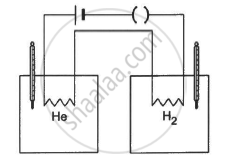Advertisements
Advertisements
प्रश्न
The figure shows two vessels with adiabatic walls, one containing 0.1 g of helium (γ = 1.67, M = 4 g mol−1) and the other containing some amount of hydrogen (γ = 1.4, M = 2 g mol−1). Initially, the temperatures of the two gases are equal. The gases are electrically heated for some time during which equal amounts of heat are given to the two gases. It is found that the temperatures rise through the same amount in the two vessels. Calculate the mass of hydrogen.

उत्तर
Given:
Mass of He, mHe = 0.1 g
γ1 = 1.67
Molecular weight of He, MHe = 4 g/mol
MH2 = ?
MH2 = 2 g/mol
γ2 = 1.4
Since it is an adiabatic environment and the system is not dong any external work, the amount of heat given will be used up entirely to raise its internal energy.
For He, dQ = dU = nCvdT ...(i)
`= "m"/4 xx "R"/(gamma-1) xx "d""T"`
`= 0.1 /4 xx "R"/((1.67 -1)) xx "d""T"`
For H2, dQ =dU = nCvdT ...(ii)
=`"m"/2 xx "R"/(gamma-1) xx "d""T"`
=`"m"/2 xx "R"/(1.4-1) xx "d""T"`
where m is the required mass of H2.
Since equal amount of heat is given to both gases; so dQ is same in both eq (i) and (ii), we get
`0.1/4 xx "R"/0.67""d""T"`
`= "m"/2 xx "R"/0.4 xx"d""T"`
`= m = 0.1/2 xx 0.4 /0.67`
`=> m =0.0298 ≈ 0.03 "g"`
APPEARS IN
संबंधित प्रश्न
The specific heat capacity of water is
Does a gas have just two specific heat capacities or more than two? Is the number of specific heat capacities of a gas countable?
Can we define specific heat capacity for an adiabatic process?
Can a process on an ideal gas be both adiabatic and isothermal?
Can two states of an ideal gas be connected by an isothermal process as well as an adiabatic process?
Two samples A and B are initially kept in the same state. Sample A is expanded through an adiabatic process and the sample B through an isothermal process. The final volumes of the samples are the same. The final pressures in A and B are pA and pBrespectively.
Let ∆Wa and ∆Wb be the work done by the systems A and B, respectively, in the previous question.
A mixture contains 1 mole of helium (Cp = 2.5 R, Cv = 1.5 R) and 1 mole of hydrogen (Cp= 3.5 R, Cv = 2.5 R). Calculate the values of Cp, Cv and γ for the mixture.
In Joly's differential steam calorimeter, 3 g of an ideal gas is contained in a rigid closed sphere at 20°C. The sphere is heated by steam at 100°C and it is found that an extra 0.095 g of steam has condensed into water as the temperature of the gas becomes constant. Calculate the specific heat capacity of the gas in J g−1 K−1. The latent heat of vaporisation of water = 540 cal g−1
The speed of sound in hydrogen at 0°C is 1280 m s−1. The density of hydrogen at STP is 0.089 kg m−3. Calculate the molar heat capacities Cp and Cv of hydrogen.
Standing waves of frequency 5.0 kHz are produced in a tube filled with oxygen at 300 K. The separation between the consecutive nodes is 3.3 cm. Calculate the specific heat capacities Cp and Cv of the gas.
Molar specific heat of water is C = 74.7 J/mol K, its value in cal/g K is ______.
An engine takes in 5 moles of air at 20°C and 1 atm, and compresses it adiabatically to `1/10^"th"` of the original volume. Assuming air to be a diatomic ideal gas made up of rigid molecules, the change in its internal energy during this process comes out to be X kJ. The value of X to the nearest integer is ______.
A diatomic molecule can be modelled as two rigid balls connected with spring such that the balls can vibrate with respect to centre of mass of the system (spring + balls). Consider a diatomic gas made of such diatomic molecule. If the gas performs 20 Joule of work under isobaric condition, then heat given to the gas is ______ J.
If at same temperature and pressure, the densities for two diatomic gases are respectively d1 and d2 then the ratio of velocities of sound in these gases will be ______.
